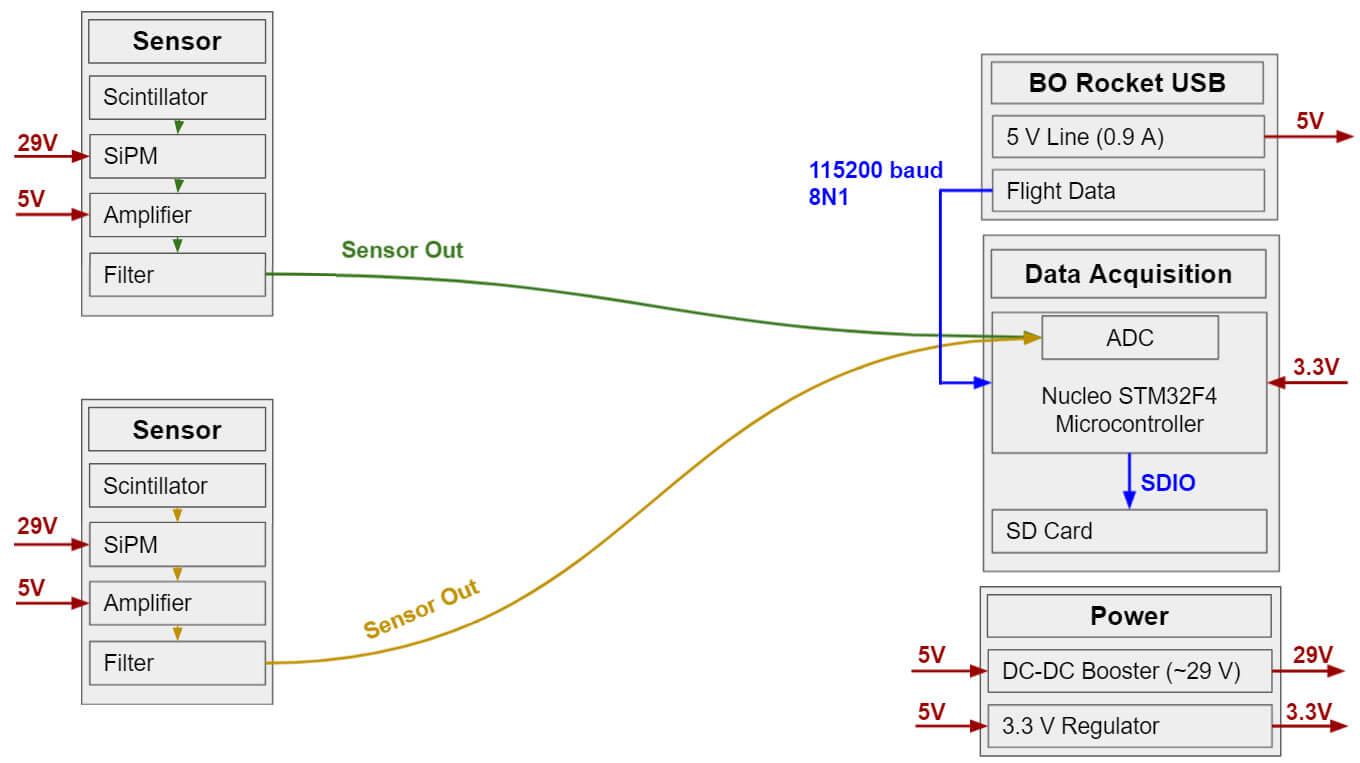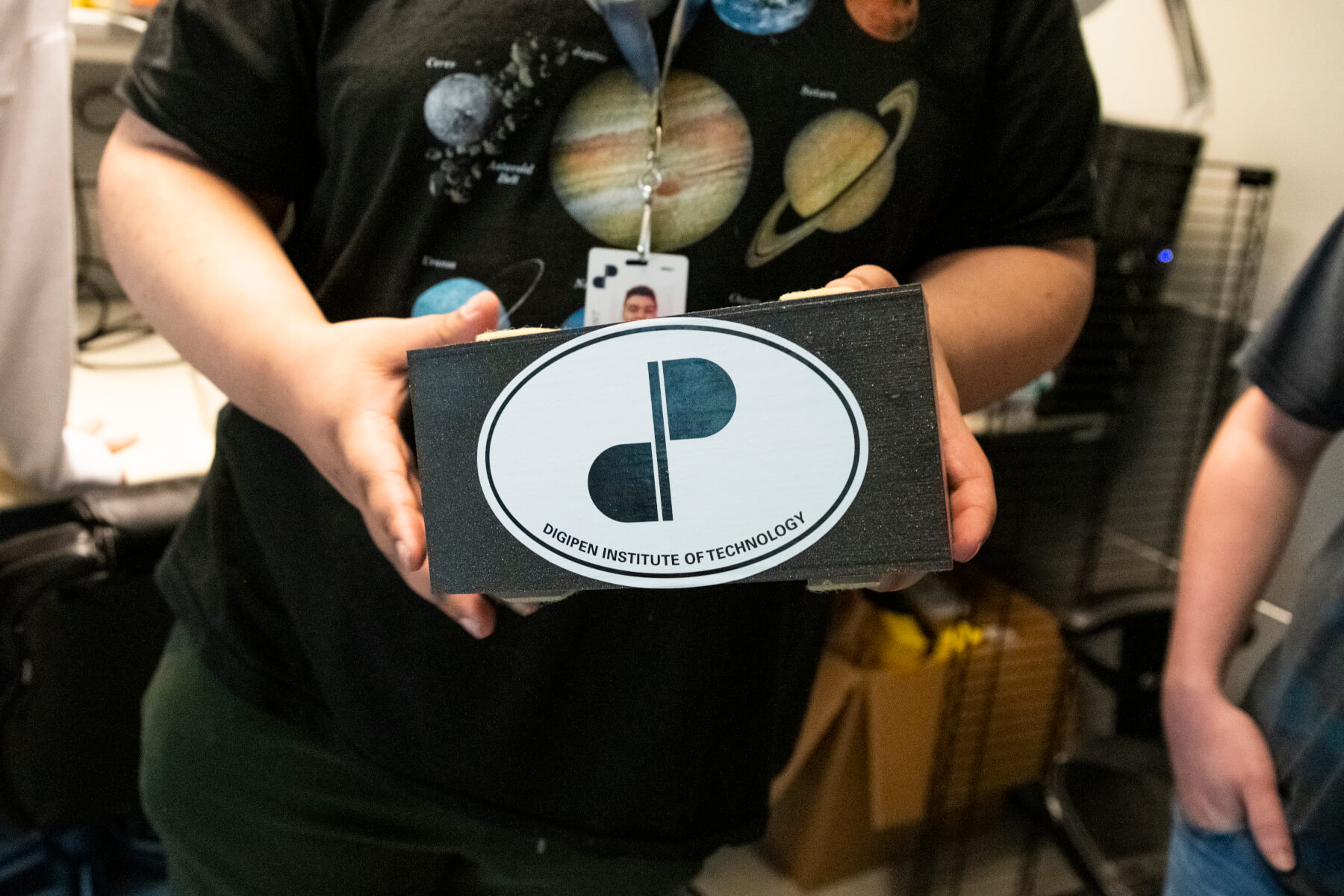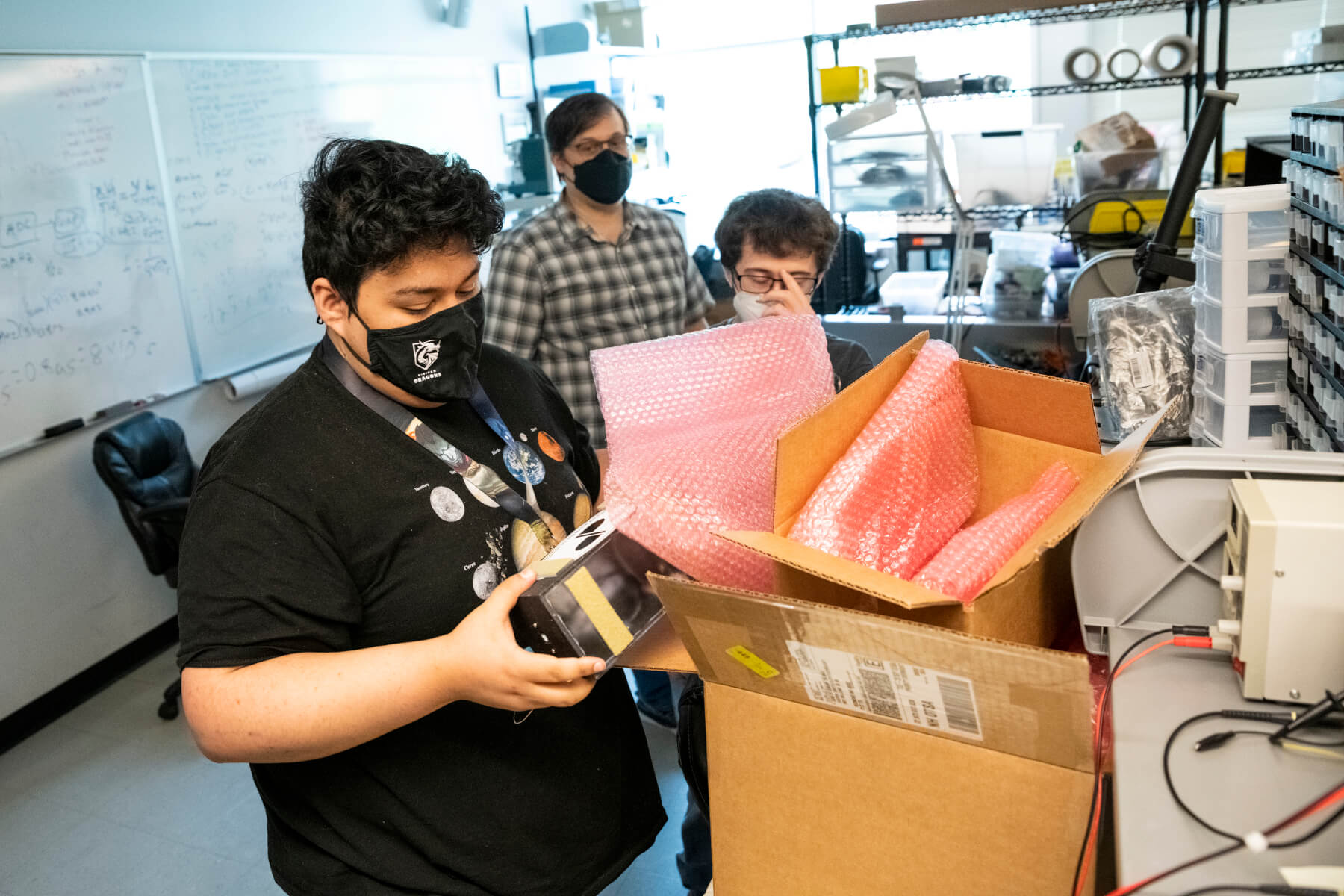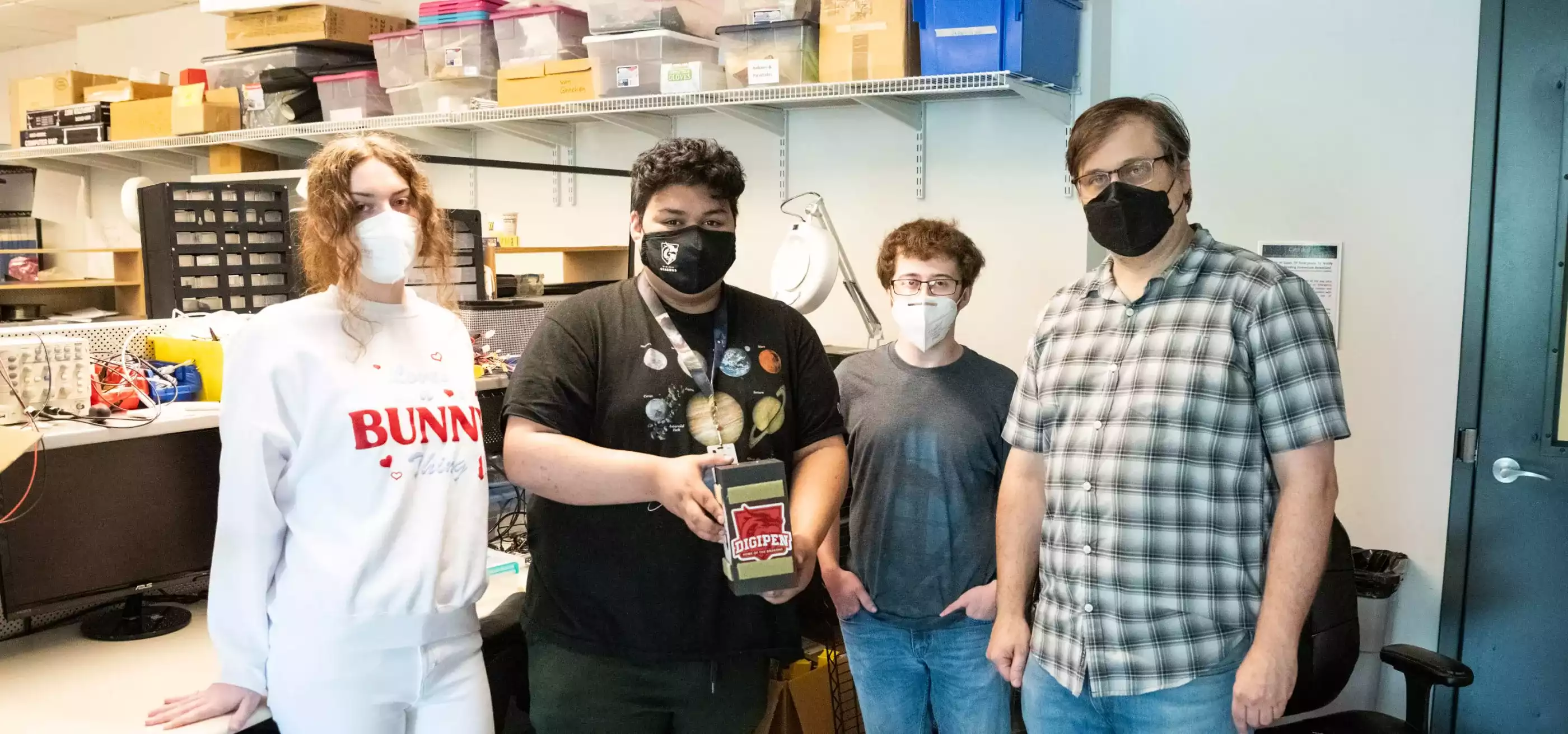Michael Espinosa Valencia was among the thousands of viewers who watched with anticipation as Blue Origin’s New Shepard rocket lifted off from Launch Site One in West Texas on its 23rd mission to space. It was more than mere curiosity, however, that prompted the DigiPen senior to tune in to the September 12 livestreamed event. He had a personal stake in the mission’s success.
For more than two years, Espinosa Valencia — along with a handful of fellow students, faculty, and alumni from the BS in Computer Engineering program — had invested untold hours into an experimental computer engineering project, a low-cost sensor system for detecting and measuring the presence of energetic particles. That project was one of 36 payloads inside the New Shepard capsule. As he watched the rocket begin its ascent, Espinosa Valencia could only trust that the sensor system was likewise beginning its own process of gathering and recording particle data.
“Seeing the rocket launch with our payload was a relief because we had spent so much time working on it,” Espinosa Valencia says. “Since it’s my first time working on something like this, I did feel a bit of uncertainty as to whether or not the sensor would work, even though I tested it countless times.”
Although various energetic particle detector systems have existed for decades, including others that have been similarly tested in space, this one was created with a particular aim in mind.
“The research goal is to make a sensor that is lower cost and lighter weight compared to ones used previously, which can measure energetic particles from the ground to near-space,” Dr. Jeremy Thomas, program director for the BS in Computer Engineering program, says. “This only cost a few hundred dollars in materials to make and it weighs 1.1 pounds.”
Student learning outcomes were also crucial, as Thomas points out. “This project synthesizes coursework in programming, electronics, and physics with a daunting final field test — a sounding rocket in space,” he says. “It is especially rare for undergraduate students to get this type of opportunity.”
For those who may be wondering, energetic particles include protons, electrons, muons, gamma rays, and heavier ions. The DigiPen sensor is most sensitive to muons in the lower atmosphere, where a muon is a heavier electron. Like an electron, a muon is a negatively charged fundamental particle.
“Muons are secondary cosmic ray particles,” Camille Aitken, another senior from the project team, says. “We don’t get them directly from the cosmos. We get them once the primary cosmic ray particles interact with the atmosphere.”
To detect these muon particles, as well as primary energetic particle such as protons in the upper atmosphere, the students built a system that senses particles and produces an electrical current related to the particle’s energy.

The system that flew aboard the New Shepard rocket system uses two sensors that function identically. The first sensor component is a plastic scintillator, which produces light (photons) when particles pass through. The resulting photons then pass through a silicon photomultiplier that converts the photons into a tiny electric current. This current waveform then gets boosted and extended through a built-in voltage amplifier. That waveform data is in turn digitized and gets sent to a microcontroller, which writes the data onto an SD card for post-processing. By having two sensors, the team can compare and crosscheck the data received from each system.
“[We’re] making sure that what we saw wasn’t just random noise,” graduate Lindsay Anderson, one of the original project team members, says.
Getting the sensor system to the point of liftoff was a long time coming. After first announcing the space flight project back in 2020, DigiPen’s initial Blue Origin payload spot was bumped to a later date. Because of that delay, students had more time to iterate on their initial prototype. When the original team of four students graduated in 2021, a new cohort was ready to take up the baton.
“Having more time always helps, especially with projects like this,” Espinosa Valencia says. “There were some things in the firmware that we might not have noticed and would have harmed the data that we got from our old payload.”
For such a tiny piece of hardware, it would be easy to underestimate the sheer number of tasks and challenges that went into piecing it all together. In addition to designing the electrical and mechanical components of the sensor system itself, students also had to program the bedrock firmware and software programs that allow the system microcontroller to communicate with the sensors and write incoming data onto an SD card — all at lightning-fast speeds (millions of samples per second). Students also developed the post-processing software used to reconstruct the waveform data from the captured particles. On top of all that, students had to ensure that every component conformed to Blue Origin’s strict requirements and operational guidelines.

“The fun part was 3D printing the box and making sure it met specifications, because we had a limit of 1.1 pounds,” Espinosa Valencia says.
With so many components to design and build, it all resulted in an equally long list of items to test, troubleshoot, and refine prior to the day of launch.
“First, you have to make sure that all the hardware is working correctly. There were many times when something wasn’t plugged in right on the sensors, or a part broke. You then have to go on the oscilloscope and make sure each different pin associated with that part is working correctly,” Espinosa Valencia says.
In the end, the September launch event was shortened due to an anomaly, but the payload was recovered and promptly shipped back to the Redmond campus. Just 10 days after the launch event, the computer engineering team tore open the 3D-printed box containing the sensor system to retrieve the SD card with the newly-recorded particle data. Upon examining the card’s contents using the team’s custom-built post-processing software — developed primarily by BS in Computer Engineering seniors James Hatfield and Kai Nobusada — the initial results looked promising. Eventually, team members say, that post-processing software will play an even bigger role, not only in verifying the recorded waveform particle data, but also in creating new avenues of research that could be taken up by future students at DigiPen. “I’m incredibly happy so far with the results from our sensor,” Espinosa Valencia says. “I can’t wait to analyze the data more closely to determine just how well it performed and what we can improve on for next time.” For now, the students and faculty can celebrate an important milestone.
“It’s hard to state the hundreds of hours these students dedicated to this project,” Professor Christian Hassard, formerly of the Department of Electrical and Computer Engineering, says. “This is a project in which you normally have a team of several dedicated, specialized engineers —one who is working completely on the mechanical part, another on the SD card communication task protocol, optimizing the firmware. These students did all of that in two years.”

Energetic Particle Detector – CE Project Team
Current Students (BS in Computer Engineering)
- Camille Aitken
- James Hatfield
- Kai Nobusada
- Michael Espinosa Valencia
Graduates (BS in Computer Engineering, Class of 2021)
- Lindsey Anderson (now at Andrews Cooper)
- Jonathan Kornich (now at SpaceX)
- Collin MacDicken (now at Echodyne)
- Nadine Martinez (now at Echodyne)
Faculty
- Christian Hassard, PhD, Assistant Professor of Electrical and Computer Engineering (now at Meta)
- Natalia Solorzano, PhD, Associate Professor of Physics
- Jeremy Thomas, PhD, Associate Professor of Electrical and Computer Engineering
